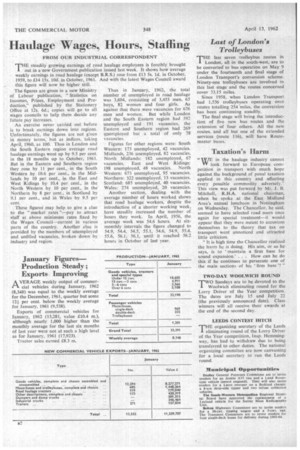Haulage Wages, Hours, Staffing
Page 36

If you've noticed an error in this article please click here to report it so we can fix it.
FROM OUR INDUSTRIAL CORRESPONDENT
THE steadily growing earnings of road haulage employees is forcibly brought out in a new Government publication issued last week. It shows how average weekly earnings in road haulage (except B.R.S.) rose from £13 5s. Id. in October, 1959, to £14 15s. 10d. in October, 1961. And with the latest Wages Council award this figure will now be higher still.
The figures are given in a new Ministry of Labour publication, "Statistics on Incomes, Prices, Employment and Production," published by the Stationery Office at 12s. 6d.; copies will go to all wages councils to help them decide any future pay increases.
An exercise never carried out before is to break earnings down into regions. Unfortunately, the figures are not g;ven in money terms, but as indices. taking April, 1960, as 100. Thus in London and the South Eastern region average road haulage earnings went up by 9.5 per cent. in the 18 months up to October, 1961. But in the Eastern and Southern region they rose by 11 per cent., in the South Western by 10.6 per cent., in the Midlands by 10 per cent., in the East and West Ridings by 10.4 per cent., in the North Western by 10 per cent., in the Northern by 8 per cent., in Scotland by 9.1 ner cent., and in Wales by 9.5 per cent.
These figure may help to give a clue to the "market rates "—pay to attract staff at above minimum rates fixed by the Wages Council—current in various parts of the country. Another clue is provided by the numbers of unemployed and unfilled vacancies, broken down by industry and region. Thus in January, 1962, the total number of unemployed in road haulage was 3,604, consisting of 3,453 men, 65 boys, 82 women and four girls. As against that there were vacancies for 676 men and women. But while London and the South Eastern region had 592 unemployed and 191 vacancies, the Eastern and Southern region had 269 upemployed hut a total of only 78 vacancies.
Figures for other regions were: South Western: 173 unemployed, 42 vacancies. Midlands, 236 unemployed, 82 vacancies. North Midlands: 182 unemployed, 67 vacancies. East and West Ridings: 198 unemployed, 48 vacancies. North Western: 673 unemployed, 95 vacancies. Northern: 322 unemployed, 13 vacancies. Scotland: 685 unemployed, 40 vacancies. Wales: 274 unemployed, 20 vacancies.
Another section, dealing with the average number of hours worked shows that road haulage workers, despite the introduction of a shorter working week, have steadily increased the number of hours they work. In April, 1956, the average week was 54.6 hours. At sixmonthly intervals the figure changed to 54.9, 54.4, 54.5, 55.1, 54.6, 54.9, 55.4, 55.6, 56.1, 56.1, until it reached 56.2 hours in October of last year.




















































































































